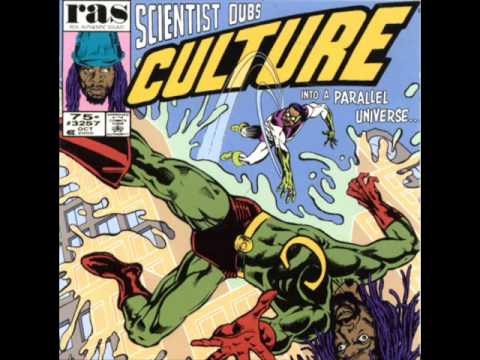Scientist vs. Culture – Intergalactic Explosion (Scientist Dubs Culture Into a Parallel Universe)
Credits:
Performers:
Lead Vocals: Joseph Hill
Drums: Phanso
Bass: Glen Browne
Guitars: Wayne Armond, Dwight Pinkney, Andrew Simpson
Percussion: Sticky, Harry T, Joseph Hill
Keyboards: Christopher Birch, Clive Hunt
Drum programming: Rohan Dwyer
Harmonica: Paul Davidson
Melodica: Seyoum Netfa
Horns: Nambo, Chico Green, Bobby Ellis, Barry Barley, Everton Gale
Flutes: Egbert Evans
Sax: Piccolo
Production Credits
Produced by: Clive Hunt
Dub Production by Scientist at Sonic Jungle Recording Studio, Hollywood CA
Recorded at Tuff Gong, Mixing Lab & Selietion, Kingston JA
Mastered by: Jim Fox at www.lionfox.com
Cover art & design by Eric White at www.ewhite.com
Interior layout & design by JML Design at www.jmldesign.com
All song written by: Joseph Hill
Published by: Tafari Music, Inc (ASCAP)
Scientist (Hopeton Brown) a mixing and engineering genius from Kingston, Jamaica, was a protégé of King Tubby, one of the originators of dub music.
Scientist interview excerpt:
LS: What is Dub?
HB: Dub is the part of reggae where the engineer manipulates what the musician put on tape to achieve different textures: by adding or taking away the lyrics, moving instruments slightly up or down, adding effects to the instruments and placement of the instruments to get a certain texture.
LS: Whom did Dub originate with?
HB: I can’t say for sure but it partially originated from Tubby who developed certain elements of dub like reverb. Back in the day we used 45’s and you couldn’t have the next side of the record blank; when you put two different records on the same vinyl you’re selling two commodities for the price of one. So, what happened back in the late 60’s and early 70’s was they used to just put the plain rhythms just as the musician played it.
LS: What is reverb?
HB: For example, if you go into cave and say “YEAH!” you hear a double voice. That’s reverb. You have natural reverb vibration, and then you have natural echoes. In this century they have digital reverbs where they simulate that same natural environment and put it into a chip. Back in the day, we used to use the “spring and coil” method, which consists of a transducer that drives a coil, and then you have a receiver on the next end that’s picking up the vibration from the coil. You also put a speaker box in one corner of the room and you put a microphone to the farthest corner of the room; that’s another way to achieving reverb.
LS: How did remixing Dub start?
HB: All of that really started from the turntables of various sound systems. People on the sound would take out the bass and then slowly bring it back in, so all you heard was treble while playing the record. Or, they might drop or shake the reverb spring to make the “thunder effect.” So dub remix really started from that and since Tubby—like myself—was an electronics engineer and he had a studio, he was able to manipulate the music even further because each instrument had its own track. So, not only could you take out the bass, you could pull up the drums, put in the guitar, and place the effects wherever you wanted to. Therefore, that is how it started. He also had a sound system . . . King Tubby’s Hi-Fi.





